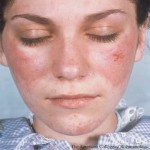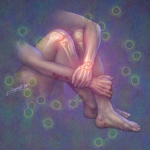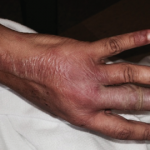Most SLE clinical trials continue standard background medications being taken by patients at entry, based on assumptions that this minimizes the risk of serious flares and that immunologic interference is minimal. These assumptions are not evidence based, but eliminating polypharmacy in trials studying patients with active lupus remains controversial. These researchers tested the withdrawal of immunosuppressants to make SLE trial results more interpretable…

One Stop: Multi-Disciplinary Lupus Clinic Meets Patient Needs
Multi-disciplinary care may be a slowly growing trend. One clinic in Ohio is raising the bar for lupus patients, serving as a one-stop center for diagnostic testing, imaging services and physical therapy. The clinic is also able to conduct basic research to advance lupus treatment and tests…

Studies Highlight Risk of Damage from Lupus Treatments
WASHINGTON, D.C.—Conference goers who braved the final day of the 2016 ACR/ARHP Annual Meeting were awarded for their stamina by learning about issues relating to the damage caused by systemic lupus erythematosus (SLE) during the session Systemic Lupus Erythematosus—Clinical Aspects and Treatment V: Damage and Morbidity. Minimizing Damage: Early Use of GC-Sparing Strategies Jayne Little,…
Biomarkers, Genetic Clues to Higher Cardiovascular Disease Risk in Patients with Lupus
WASHINGTON, D.C.—Experts at the 2016 ACR/ARHP Annual Meeting session, Systemic Lupus Erythematosus—Clinical Aspects and Treatment IV: Biomarkers, reported on a number of recent studies showing advancement in our understanding of the disease mechanisms underlying systemic lupus erythematosus (SLE) that place these patients at risk for cardiovascular disease (CVD) and other comorbidities. Mechanisms of CVD Risk…

Effectiveness of Novel Therapies for Cutaneous SLE Explored
WASHINGTON, D.C.—A new, humanized anti-BDCA2 monoclonal antibody can trigger inhibition of the production of interferon, cytokines and chemokines derived from plasmacytoid dendritic cells in patients with cutaneous systemic lupus erythematosus (SLE), according to research presented at the 2016 ACR/ARHP Annual Meeting. The findings were discussed during a session on SLE treatment, drug adherence and the…

Rheumatology Case Report: Bullous Lesions in Patient with Lupus
Systemic lupus erythematosus (SLE) is a heterogeneous disease associated with multiple acute or chronic cutaneous manifestations, including the relatively rare category of bullous lupus. The development of vesiculo-bullous lesions may be associated with a high morbidity, hence they warrant an urgent investigation, including a skin biopsy to identify the diagnosis and initiate prompt treatment. With…

Rheumatologists, Social Workers Collaborate to Help Patients with Lupus
At the Hospital for Special Surgery (HSS), New York, rheumatologists and social workers have found that an interdisciplinary approach to care for systemic lupus erythematosus (SLE) patients improves the overall patient experience. “Our goal is to help patients navigate the complex healthcare system,” says Jillian Rose, LCSW, MPH, assistant director, Community Engagement, Diversity & Research….

Weakness, Fatigue Can Signal Underlying Rheumatologic Disease
As clinicians, we are familiar with pain, stiffness and soreness—subjective nouns that define our métier. These helpful words serve as signposts that direct us along the path to the proper diagnosis. Consider the young man with a stiff, sore back (a case of ankylosing spondylitis?) or the postpartum woman experiencing newly painful, stiff and sore…

Rheumatology Research Abstracts Highlight Treatment for Hand OA, Risk of Depression in Lupus and More
WASHINGTON, D.C.—What do treating hand osteoarthritis (OA) in the primary care setting, high financial strain and risk of depression in patients with lupus, prolonged sitting and cardiovascular disease, and sex-specific treatment after total hip arthroplasty have in common? They were all topics presented during a session titled ARHP I: Exemplary Abstracts at the 2016 ACR/ARHP…

Liquid Biopsy Provides Insights into Lupus
Microparticles in the blood of SLE patients may be a source of extracellular HMGB1, which is involved in immune response. Researchers found that analysis may be able to determine if the patient is producing dead, dying and activated cells that are important for SLE pathogenesis…
- « Previous Page
- 1
- …
- 5
- 6
- 7
- 8
- 9
- …
- 19
- Next Page »